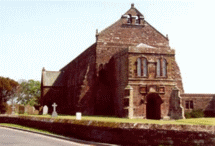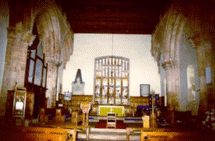| Holm Cultram was the site of a
great Cistercian Abbey with possessions and influence both wealthy and
wide-spreading. This history is preserved in its Register or
Cartulary.
Cistercian monks came from
Melrose Abbey in the middle of the 11th
Century, and settled in Cumberland under the
protection of the Scottish Crown, which happened at
the time to be dominant at Carlisle.
In the 15th Century the abbey
was much larger than it is today, in fact it was
bigger than Carlisle Cathedral.
Very little remains of the
pre-Reformation fabric, except the Transitional west
doorway, and the wall, 7 foot thick with a newel
stair in it, on either side of that door. The
present church was rebuilt in the 18th
century, leaving only six piers of the nave and the
area of walls around them. The mediaeval church was
much larger than the present building, larger indeed
than Carlisle Cathedral. It was cruciform, with a
nave of nine bays, a choir and transepts. Its total
length was 279 feet, of which the nave measured 162
feet. The greatest width of the transepts was 135
feet; the tower was 38 feet wide and eventually 114
feet high. Remnants of the Chapter House, when found
between 1872 and 1906, were judged to be of the
earliest [i.e., Transitional] period.
On 6th March 1538
the Abbey was dissolved by Henry VII. “Gavin Borrodaile, Abbott of . . . Holm Cultram .
. . do give, grant, render, deliver, and confirm to.
. .Henry VIII . . . all that Monastery of Holm
Cultram aforesaid . . . 6th March
[1538].”
The land passed to the Crown,
and the monks were dispersed. The centre of the
Abbey has survived as the Parish Church, with much
repair work needed over the intervening years to
keep it even wind and weather-tight. It survived
fire and tempest, raids from across the border, but
with the tower eventually falling. The rest of the
Abbey fell completely into disrepair, and only two
cottages survive the period.
In 1730, agreement was reached
between the Churchwardens and Richard Smirke of
Wigton, house-carpenter, "who is to set up
all pews, galleries and all other works in the
church, using wood from Wedholme [which was owned by
the parishioners]", and “to work all
wood to the best advantage as to make no waste”
etc., “all chips and shavings to be at the
Churchwardens’ disposal”.
All this cost £37.
When all was done, it was
described by Dr Waugh as – “neatly and
conveniently seated, with handsome galleries, and it
is altogether a beautiful church; but though it
stands high, [it is] strangely damp. It contains
seats for 846 persons”
EMLM 2002
|


